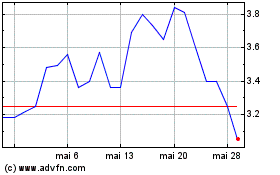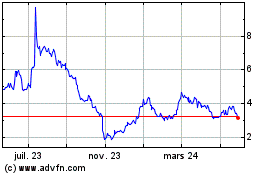Acumen Pharmaceuticals, Inc. (NASDAQ: ABOS), a clinical-stage
biopharmaceutical company developing a novel therapeutic that
targets soluble amyloid beta oligomers (AβOs) for the treatment of
Alzheimer’s disease (AD), today presented cerebrospinal fluid
(CSF) biomarker data from the sabirnetug (ACU193) Phase 1
INTERCEPT-AD trial in an oral presentation at the International
Conference on Alzheimer’s and Parkinson’s Diseases and related
neurological disorders (AD/PD) in Lisbon, Portugal, and online.
Acumen also presented a poster showcasing the method used to
develop a first-of-its-kind assay to measure target engagement of
an AβO-selective antibody.
Acumen’s sabirnetug is the first humanized
monoclonal antibody to clinically demonstrate selective target
engagement of AβOs, a soluble and highly toxic form of Aβ that
accumulates early in AD and triggers synaptic dysfunction and
neurodegeneration. Positive topline results from 62 participants
dosed in the Phase 1 INTERCEPT-AD trial (NCT04931459) were reported
in July 2023, and additional insights from exploratory analyses
have further confirmed sabirnetug’s proof-of-mechanism and broad
therapeutic potential as a next-generation treatment for early
AD.
Sabirnetug (ACU193) Lowers CSF
Neurogranin & pTau181 Levels in INTERCEPT-AD Study in Early
AD
Several key CSF biomarkers are associated with
the pathological changes that occur in AD, and evidence suggests
these biomarkers may better reflect the underlying pathology of AD
than imaging alone.i,ii Results from CSF samples collected before
and after drug exposure in the INTERCEPT-AD study were presented
and assessed for biomarkers indicative of amyloid pathology
(Aβ42/40 ratio), tau pathology (pTau181, pTau217), neuronal injury
(total tau) and synaptic injury (neurogranin).
Sabirnetug had an observed dose-dependent trend
in the multiple ascending dose cohorts on CSF levels of pTau181,
pTau217 total tau, neurogranin and the Aβ42/Aβ40 ratio, consistent
with the downstream pharmacologic effects after just three
administrations of the drug. Key findings include:
- Improvements in biomarkers associated with AD pathology,
including significantly lowered CSF levels of neurogranin (-13.9%)
and pTau181 (-13.0%) and trending toward an increasing Aβ42/40
ratio using 60 mg/kg Q4W as compared to the placebo group;
- A nominally significant correlation between target engagement
of AβOs and change in neurogranin across all doses, supportive of
drug effect; and
- A trend in correlation between target engagement of AβOs and
change in p-tau181 across all doses, also supportive of drug
effect.
These findings support a biological link between
sabirnetug and neurogranin and pTau181 and are consistent with
sabirnetug’s proposed mechanism of action and intended target
engagement of AβOs, as sabirnetug’s effects on these two biomarkers
are more closely related to binding of AβOs than plaque
reduction.
“We’re thrilled to return to AD/PD this year
since completing the Phase 1 INTERCEPT-AD trial with results from
our biomarker assessment, which further validate our confidence in
sabirnetug’s proposed mechanism of action,” said Daniel O’Connell,
Chief Executive Officer of Acumen. “As the Alzheimer’s treatment
landscape continues to evolve, we’re seeing just how important
biomarkers are to better characterize and understand the underlying
pathology of disease, and we look forward to exploring the
relationship between these biomarkers and clinical outcomes in a
longer-term Phase 2 study.”
Target Engagement in INTERCEPT-AD:
Development of a Novel Assay Measuring Sabirnetug (ACU193)-Amyloid
Beta Oligomer Complexes in Human CSF
Additionally, Acumen presented a poster
detailing its method to develop the first assay to directly measure
target engagement of AβOs by an immunotherapy (as measured by
sabirnetug-AβO complex in CSF) in the INTERCEPT-AD trial. The novel
assay configuration was tailored to selectively detect
sabirnetug-AβO complex in CSF as a direct measure of target
engagement, showing clear dose-related increases in target
engagement across all cohorts. This data also informed development
of a pharmacokinetic-pharmacodynamic (PK/PD) model, which
ultimately demonstrated that the highest doses used in INTERCEPT-AD
(60 mg/kg Q4W and 25mg/kg Q2W) approached maximal target
engagement, as was presented in October 2023.
“Despite longstanding evidence implicating
soluble AβOs as a significant driver of AD pathology, historically
it’s been difficult to measure and characterize this form of Aβ,”
said Erika Cline, Ph.D., lead author and Manager of Bioanalytical
Methods at Acumen Pharmaceuticals. “As Acumen progresses the
clinical study of the first-in-clinic antibody with high
selectivity for AβOs, the development of the first assay to detect
direct target engagement of AβOs is crucial to deepen our
understanding of how sabirnetug acts in vivo.”
Acumen is on track to initiate a Phase 2 trial
evaluating sabirnetug in the first half of 2024 and a Phase 1
subcutaneous study in mid-2024.
About Sabirnetug (ACU193)Sabirnetug (ACU193) is
a humanized monoclonal antibody (mAb) discovered and developed
based on its selectivity for soluble AβOs, which are a highly toxic
and pathogenic form of Aβ, relative to Aβ monomers and amyloid
plaques. Soluble AβOs have been observed to be potent neurotoxins
that bind to neurons, inhibit synaptic function and induce
neurodegeneration. By selectively targeting toxic soluble AβOs,
sabirnetug aims to directly address a growing body of evidence
indicating that soluble AβOs are a primary underlying cause of the
neurodegenerative process in Alzheimer’s disease. Sabirnetug has
been granted Fast Track designation for the treatment of early
Alzheimer’s disease by the U.S. Food and Drug Administration.
About INTERCEPT-ADINTERCEPT-AD was a Phase 1,
U.S.-based, multi-center, randomized, double-blind,
placebo-controlled clinical trial evaluating the safety and
tolerability, and establishing clinical proof of mechanism, of
sabirnetug in patients with early Alzheimer’s disease (AD).
Sixty-five individuals with early AD (mild cognitive impairment or
mild dementia due to AD) enrolled in this first-in-human study of
sabirnetug. The INTERCEPT-AD study consisted of
single-ascending-dose (SAD) and multiple-ascending-dose (MAD)
cohorts and was designed to evaluate the safety, tolerability,
pharmacokinetics (PK), and target engagement of intravenous doses
of sabirnetug. More information can be found on
www.clinicaltrials.gov, NCT identifier NCT04931459.
About Acumen Pharmaceuticals, Inc.Acumen,
headquartered in Charlottesville, VA, with additional offices in
Indianapolis, IN and Newton, MA, is a clinical-stage
biopharmaceutical company developing a novel therapeutic that
targets toxic soluble amyloid beta oligomers (AβOs) for the
treatment of Alzheimer’s disease (AD). Acumen’s scientific founders
pioneered research on AβOs, which a growing body of evidence
indicates are early and persistent triggers of Alzheimer’s disease
pathology. Acumen is currently focused on advancing its
investigational product candidate, sabirnetug (ACU193), a humanized
monoclonal antibody that selectively targets toxic soluble AβOs,
following positive results in INTERCEPT-AD, a Phase 1 clinical
trial involving early Alzheimer’s disease patients. For more
information, visit www.acumenpharm.com.
Forward-Looking StatementsThis press release
contains forward-looking statements within the meaning of The
Private Securities Litigation Reform Act of 1995. Any statement
describing Acumen’s goals, expectations, financial or other
projections, intentions or beliefs is a forward-looking statement
and should be considered an at-risk statement. Words such as
“potential,” “will” and similar expressions are intended to
identify forward-looking statements, although not all
forward-looking statements contain these identifying words.
Forward-looking statements include statements concerning the
therapeutic potential of Acumen’s product candidate, sabirnetug
(ACU193), Acumen’s preparations with respect to its plans to
initiate a Phase 2 study and subcutaneous study, and Acumen’s
potential to receive regulatory approval for and bring sabirnetug
to patients living with AD. These statements are based upon the
current beliefs and expectations of Acumen’s management, and are
subject to certain factors, risks and uncertainties, particularly
those inherent in the process of discovering, developing and
commercializing safe and effective human therapeutics. Such risks
may be amplified by the impacts of geopolitical events and
macroeconomic conditions, such as rising inflation and interest
rates, supply disruptions and uncertainty of credit and financial
markets. These and other risks concerning Acumen’s programs are
described in additional detail in Acumen’s filings with the
Securities and Exchange Commission (“SEC”), including in Acumen’s
most recent Annual Report on Form 10-K, and in subsequent filings
with the SEC. Copies of these and other documents are available
from Acumen. Additional information will be made available in other
filings that Acumen makes from time to time with the SEC. These
forward-looking statements speak only as of the date hereof, and
Acumen expressly disclaims any obligation to update or revise any
forward-looking statement, except as otherwise required by law,
whether, as a result of new information, future events or
otherwise.
Investors: Alex Braunabraun@acumenpharm.com
Media:Jessica LaubICR
Westwicke AcumenPR@westwicke.com
i Tarawneh, R. Biomarkers: Our Path Towards a Cure for Alzheimer
Disease. Biomarker Insights Volume 15: 1–15. 2020.ii Blennow K,
Zetterberg H. The Past and the Future of Alzheimer's Disease Fluid
Biomarkers. J Alzheimers Dis. 2018;62(3):1125-1140.
Acumen Pharmaceuticals (NASDAQ:ABOS)
Graphique Historique de l'Action
De Jan 2025 à Fév 2025

Acumen Pharmaceuticals (NASDAQ:ABOS)
Graphique Historique de l'Action
De Fév 2024 à Fév 2025


